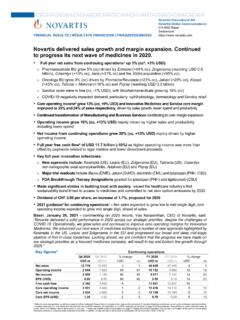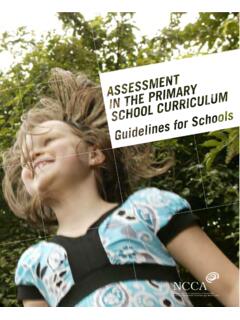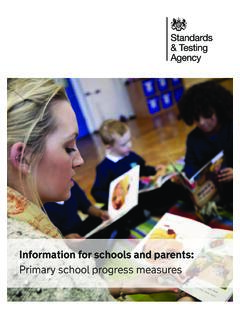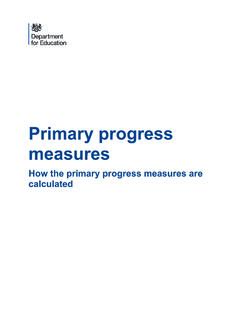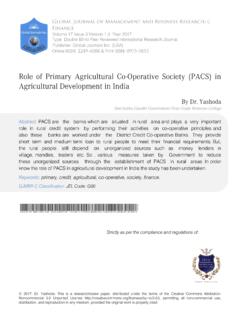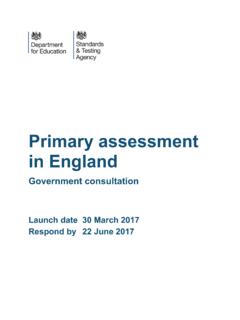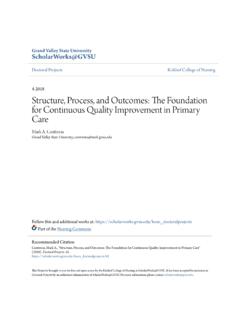Transcription of How Progress 8 and Attainment 8 measures are calculated
1 Progress 8. How Progress 8 and Attainment 8. measures are calculated Summary of Progress 8 and Attainment 8. Progress 8 was introduced in 2016 (and 2015 for schools that chose to opt in early). It aims to capture the Progress a pupil makes from the end of primary school to the end of secondary school. It is a type of value added measure , which means that pupils' results are compared to the actual achievements of other pupils with similar prior Attainment . The new performance measures are designed to encourage schools to offer a broad and balanced curriculum with a focus on an academic core at key stage 4, and reward schools for the teaching of all their pupils, measuring performance across 8. qualifications. Every increase in every grade a pupil achieves will attract additional points in the performance tables.
2 Attainment 8 measures the achievement of a pupil across 8 qualifications including mathematics (double weighted) and English (double weighted), 3 further qualifications that count in the English Baccalaureate (EBacc) measure and 3 further qualifications that can be GCSE qualifications (including EBacc subjects) or any other non-GCSE. qualifications on the DfE approved list. Each individual grade a pupil achieves is assigned a point score, which is then used to calculate a pupil's Attainment 8 score (see second step below). How we calculate Progress 8. Progress 8 compares pupils' key stage 4 results to those of other pupils nationally with similar prior Attainment . Our first step is to put all pupils nationally into prior Attainment groups based on their key stage 2 results, so that we have groups of pupils who have similar starting points to each other.
3 We do this by working out a pupils' average performance at key stage 2 across English and mathematics. Pupils' actual test results in English and maths are converted into points and an average of the points is taken to create an overall point score. Pupils are then allocated into prior Attainment groups with other pupils who have the same key stage 2 point scores as them. Our second step is to work out a pupil's Attainment 8 score. The points allocated according to grades the pupil achieves for all 8 subjects are added together to give the Attainment 8 score. English and maths point scores are double weighted to signify their importance. The points that pupils are allocated for each grade are in the table below: 2. GCSE grade 2016 Points 2017 and 2018 Points G F E D C B A A* In 2017, new GCSE qualifications in English and mathematics, graded 1-9, will be included in performance tables, with others to follow in 2018 and 2019.
4 Points will be allocated to the new GCSEs on a 1-9 point scale corresponding to the new 1 to 9 grades, a grade 9 will get 9 points in the performance measures . To minimise change, unreformed GCSEs and all other qualifications will be mapped onto the 1-9 scale from 2017 (with being the maximum points available for unreformed GCSEs). Our third step is to calculate individual pupil's Progress 8 score. Progress 8 is calculated for individual pupils solely in order to calculate a school's Progress 8 score. There is no need for schools to share individual Progress 8 scores with their pupils. Schools should continue to focus on which qualifications are most suitable for individual pupils, as the grades pupils achieve will help them reach their goals for the next stage of their education or training.
5 The calculation is as follows: We take the individual pupil's Attainment 8 score (for example 56). We compare this to the national average Attainment 8 score for pupils in the same prior Attainment group. A pupil's Progress score is the difference between their actual Attainment 8 result and the average result of those in their prior Attainment group. If David, for example, achieved an Attainment 8 score of 56 and the average Attainment 8 score for his prior Attainment group was 55 - his Progress score would be +1. We divide +1 by 10 to give an individual pupil's Progress 8 score, which is in this example is Our final step is to create a school level Progress score. We do this by adding together the Progress 8 scores of all the pupils in year 11 and dividing by the number of pupils in the school.
6 3. Interpreting a school's Progress 8 score Progress 8 scores will be centred around 0, with most schools within the range of -1 to +1. A score of 0 means pupils in this school on average do about as well at KS4 as those with similar prior Attainment nationally. A positive score means pupils in this school on average do better at KS4 as those with similar prior Attainment nationally. A negative score means pupils in this school on average do worse at KS4 as those with similar prior Attainment nationally. A negative score does not mean that pupils did not make any Progress ; rather it means they made less Progress than other pupils nationally with similar starting points. For example, if a school has a Progress 8 score of this would mean that, on average, pupils in this school achieved a quarter of a grade less than other pupils nationally with similar starting points.
7 Confidence intervals Progress 8 results are calculated for a school based on a specific cohort of pupils. A. school may have been just as effective but have performed differently with a different set of pupils. To account for this natural uncertainty 95% confidence intervals around Progress 8 scores are provided as a proxy for the range of scores within which each school's underlying performance measure can be confidently said to lie. In addition, the greater the number of students, the smaller the range of the confidence interval. For smaller schools the confidence interval tends to be larger, since fewer pupils are included, and therefore the score could be impacted by performance of an individual pupil more than would be the case in a larger school. We publish the 95%. confidence intervals alongside a school's Progress scores to reflect this uncertainty and provide context to Progress scores of smaller schools.
8 Confidence intervals are presented as two numbers the lower and upper limits within which we are 95% confident the performance of a school may lie. If the lower confidence limit is greater than zero it can be interpreted as meaning that the school has achieved greater than average Progress compared to pupils with similar starting points nationally. Similarly, if the upper confidence limit is below zero, then the school has made less than average Progress . Where a confidence interval overlaps zero, this means that the school's Progress score is not significantly different from the national average. 4. Crown copyright 2016. This publication (not including logos) is licensed under the terms of the Open Government Licence except where otherwise stated. Where we have identified any third party copyright information you will need to obtain permission from the copyright holders concerned.
9 To view this licence: visit email write to Information Policy Team, The National Archives, Kew, London, TW9 4DU. About this publication: enquiries download Reference: DFE-00252-2016. Follow us on Twitter: Like us on Facebook: @educationgovuk 5.










